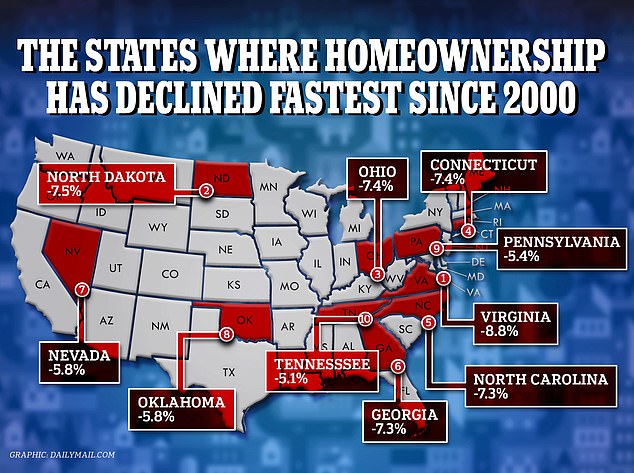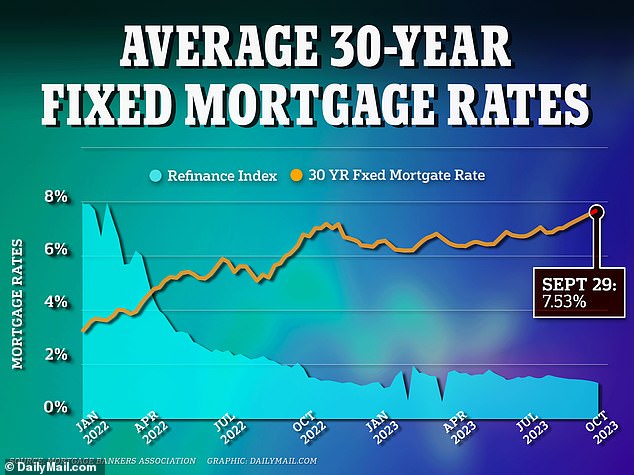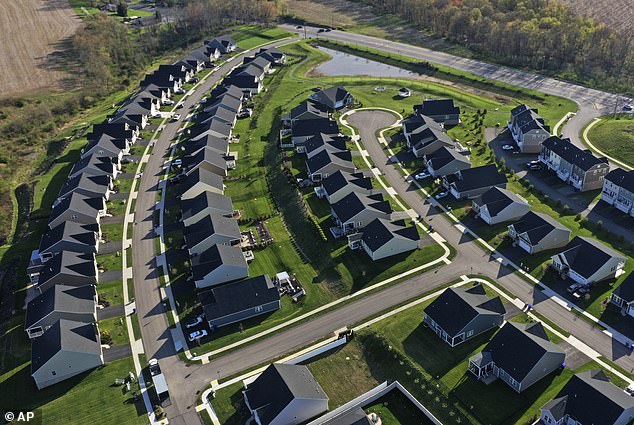The decline of American homeownership: Study reveals which states have seen the steepest decline in property owners since 2000
The Decline in US Home Ownership: Research Shows Which States Have Seen the Biggest Decline in the Number of Property Owners Since 2000
- Research shows that Virginia has experienced the largest decline in homeownership since 2000
- It was followed by California, North Dakota, Ohio and Connecticut
- This research comes at a time when mortgage rates reached 7.5 percent for the first time since 2000
<!–
<!–
<!–
<!–
<!–
<!–
Owning a home was once considered an important part of achieving the American dream. But for Virginians, that dream is quickly fading.
The Old Dominion state in the U.S. is experiencing the largest decline in homeownership since 2000, according to a new report.
About 67.4 percent of Virginians owned their own home in 2022, up from 73.9 percent at the turn of the millennium.
Overall, the number of owners fell by 8.8 percent – the steepest decline of any US state, according to figures from Californian platform RubyHome Luxury Real Estate.
It was followed by North Dakota, which experienced a decline of 7.5 percent, and Ohio and Connecticut, which both experienced declines of 7.4 percent.

About 67.4 percent of Virginians owned their own home in 2022, up from 73.9 percent at the turn of the millennium
The top ten states were completed by: North Carolina, Georgia, Nevada, Oklahoma, Pennsylvania and Tennessee.
Of those listed, Nevada had the lowest percentage of homeowners; only 64 percent of the state’s residents owned their own home.
The survey was compiled based on figures from the US Census Bureau.
Experts noted that the figures indicated a downward trend in the US, showing that younger generations are far less likely to own a home than their parents.
A spokesperson for RubyHome said: ‘With the general trend since 2000 dictating that today’s younger generation is less likely to own a home than their parents, it will be interesting to see which states are most susceptible to this phenomenon.
“It will be relevant to see whether the homeownership rate continues to decline or whether the most affected states can reverse the trend.”
Aspiring homeowners are currently facing a perfect storm of high mortgage rates that are keeping homeowners from moving.


U.S. mortgage rates have risen above 7.5 percent for the first time since November 2000, according to data from the Mortgage Bankers Association.


Figures from the Atlanta Federal Reserve show that Americans have faced the least affordable housing market since 2006.
Many contracts had a term of thirty years while the interest rate was around 2 percent, so they were effectively stuck in their current home.
It comes after data from the Atlanta Federal Reserve showed that Americans faced the least affordable housing market since 2006.
And data released today by the Mortgage Bankers Association shows that mortgage rates have topped 7.5 percent for the first time since 2000.
But it’s not all bad news, as data from real estate portal Zillow shows that the number of sellers lowering the price of their homes has risen to an all-time high this year.
About 9.2 percent of listings saw their asking prices reduced in the week to September 23 – compared to 6 percent in April and 7.9 percent in the same week in September 2019.
Although there is a cooldown after summer every year, economists noted that the trend has accelerated this fall.
Zillow senior economist Jeff Tucker wrote in a report that fall could be a sweet spot for aspiring homebuyers — as long as they’re willing to deal with higher mortgage rates.
